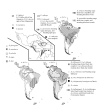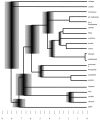Habitat shifts in the evolutionary history of a Neotropical flycatcher lineage from forest and open landscapes
- PMID: 18601752
- PMCID: PMC2467406
- DOI: 10.1186/1471-2148-8-193
Habitat shifts in the evolutionary history of a Neotropical flycatcher lineage from forest and open landscapes
Abstract
Background: Little is known about the role ecological shifts play in the evolution of Neotropical radiations that have colonized a variety of environments. We here examine habitat shifts in the evolutionary history of Elaenia flycatchers, a Neotropical bird lineage that lives in a range of forest and open habitats. We evaluate phylogenetic relationships within the genus based on mitochondrial and nuclear DNA sequence data, and then employ parsimony-based and Bayesian methods to reconstruct preferences for a number of habitat types and migratory behaviour throughout the evolutionary history of the genus. Using a molecular clock approach, we date the most important habitat shifts.
Results: Our analyses resolve phylogenetic relationships among Elaenia species and confirm several species associations predicted by morphology while furnishing support for other taxon placements that are in conflict with traditional classification, such as the elevation of various Elaenia taxa to species level. While savannah specialism is restricted to one basal clade within the genus, montane forest was invaded from open habitat only on a limited number of occasions. Riparian growth may have been favoured early on in the evolution of the main Elaenia clade and subsequently been deserted on several occasions. Austral long-distance migratory behaviour evolved on several occasions.
Conclusion: Ancestral reconstructions of habitat preferences reveal pronounced differences not only in the timing of the emergence of certain habitat preferences, but also in the frequency of habitat shifts. The early origin of savannah specialism in Elaenia highlights the importance of this habitat in Neotropical Pliocene and late Miocene biogeography. While forest in old mountain ranges such as the Tepuis and the Brazilian Shield was colonized early on, the most important colonization event of montane forest was in conjunction with Pliocene Andean uplift. Riparian habitats may have played an important role in facilitating habitat shifts by birds expanding up the mountains along streams and adapting to newly emerging montane forest habitat.
Figures






References
Publication types
MeSH terms
Substances
Associated data
- Actions
- Actions
- Actions
- Actions
- Actions
- Actions
- Actions
- Actions
- Actions
- Actions
- Actions
- Actions
- Actions
- Actions
- Actions
- Actions
- Actions
- Actions
- Actions
- Actions
- Actions
- Actions
- Actions
- Actions
- Actions
- Actions
- Actions
- Actions
- Actions
- Actions
- Actions
- Actions
- Actions
- Actions
- Actions
- Actions
- Actions
- Actions
- Actions
- Actions
- Actions
- Actions
- Actions
- Actions
- Actions
- Actions
- Actions
- Actions
- Actions
- Actions
- Actions
- Actions
- Actions
- Actions
- Actions
- Actions
- Actions
- Actions
- Actions
- Actions
- Actions
- Actions
- Actions
- Actions
- Actions
- Actions
- Actions
- Actions
- Actions
- Actions
- Actions
- Actions
- Actions
- Actions
- Actions
- Actions
- Actions
- Actions
- Actions
- Actions
- Actions
- Actions
- Actions
- Actions
- Actions
- Actions
- Actions
- Actions
- Actions
- Actions
- Actions
- Actions
- Actions
- Actions
- Actions
- Actions
- Actions
- Actions
- Actions
- Actions
- Actions
- Actions
- Actions
- Actions
- Actions
- Actions
- Actions
- Actions
- Actions
- Actions
- Actions
- Actions
- Actions
- Actions
- Actions
- Actions
- Actions
- Actions
- Actions
- Actions
LinkOut - more resources
Full Text Sources

